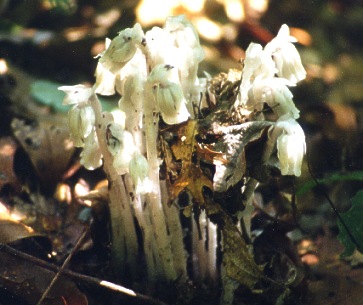Monotropa uniflora

Blooms June to October
Although resembling a fungi in looks and texture, this is actually a member of the same family as Rhododendron, Ericaceae. It is found in deciduouds woodlands across the state.
There is a great story about Indian Pipes told by Mary Chiltosky in the book, Cherokee Plants...
"Before selfishness came into the world-that was a long time ago- the Cherokee people were happy sharing the hunting and fishing places with their neighbors. All this changed when Selfishness came into the world and man began to quarrel. The Cherokee quarreled with tribes on the east. Finally the chiefs of several tribes met in council to try to settle the dispute. They smoked the pipe and continued to quarrel for seven days and seven nights. This displeased the Great Spirit because people are not supposed to smoke the pipe until they make peace. As he looked upon the old men with heads bowed, he decided to do something to remind people to smoke the pipe only at the time they make peace."
"The Great Spirit turned the old men into greyish flowers we now call "Indian Pipes" and he made them grow where friends and relatives have quarreled. He made the smoke hang over these mountains until all the people all over the world learn to live together in peace."
Indian Pipe root has been traditionally used as a sedative and for various nervous conditions. It was also used externally for inflamed eyes and bunions and warts. Water extracts are bactericidal. WARNING- Safety is undetermined and it is possibly toxic as it contains several glycosides.

NC Range of Indian Pipes